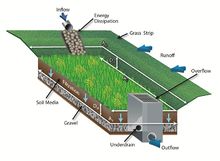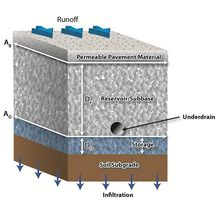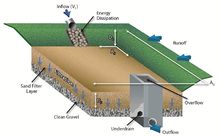
Difference between revisions of "Stormwater filtration Best Management Practices"
m |
m |
||
| Line 25: | Line 25: | ||
**[[Filtration devices]] | **[[Filtration devices]] | ||
| − | + | <!-- | |
<gallery caption="Examples of filtration systems. Click on an image for enlarged view." widths="220px"> | <gallery caption="Examples of filtration systems. Click on an image for enlarged view." widths="220px"> | ||
File:Biofiltration 1 for credit page.jpg|alt=Schematic showing biofiltration|Schematic of a biofiltration BMP. | File:Biofiltration 1 for credit page.jpg|alt=Schematic showing biofiltration|Schematic of a biofiltration BMP. | ||
| Line 31: | Line 31: | ||
File:Sand filter credit article.jpg|Schematic of a sand filter BMP. | File:Sand filter credit article.jpg|Schematic of a sand filter BMP. | ||
</gallery> | </gallery> | ||
| + | --> | ||
Revision as of 13:57, 30 April 2015
Filtration Best Management Practices (BMPs) treat urban stormwater runoff as it flows through a filtering medium, such as sand or an organic material. They are generally used on small drainage areas (5 acres or less) and are primarily designed for pollutant removal. Filtering BMPs are designed only for pollutant removal, and do not reduce peak flows for flood control or channel protection. These BMPs have not been widely applied in cold climates (CWP, 1997), but some filtering systems have the potential to be valuable BMPs in these regions.
The following practices typically employ an underdrain, which captures most of the runoff that enters the BMP. For information on these BMPs with no underdrain, see Infiltration practices.
Other filtration BMPs, including pre-treatment practices
Manufactured devices


